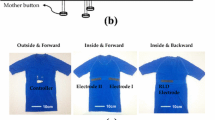Abstract
The electro-conductive fabric (e-textile or e-fabric) as an electrode for ECG measurement is one of the best application for ubiquitous healthcare system. However, it is difficult to measure the bio-signal due to its sensitivity variation caused by impedance change, especially by motion of the subject. In this paper, adaptive motion artifacts reduction using motion information from 3-axis accelerometer is proposed and analyzed in quantitative manner.



Similar content being viewed by others
Explore related subjects
Discover the latest articles and news from researchers in related subjects, suggested using machine learning.References
Lymberis, A., Progress in R&D on wearable and implantable biomedical sensors for better healthcare and medicine. IEEE EMBS Proc. 3rd Annual International Special Topic Conference on Microtechnologies in Medicine and Biology. Kahuku, Oahu, Hawaii, USA, 296–298, 2005, 12–15 May.
Tanaka, S., Motoi, K., Nogawa, M., and Yamakoshi, K., A new portable device for ambulatory monitoring of human posture and walking velocity using miniature accelerometers and gyroscope. IEEE EMBS Proc., 26th Annual International Conference, San Francisco, CA, USA, 3:2283–2286, 2004, 1–5 Sept.
Loriga, G., Taccini, N., De Rossi, D., and Paradiso, R., Textile sensing interfaces for cardiopulmonary signs monitoring. IEEE EMBS Proc., 27th Annual International Conference, Shanghai, China, 7349–7352, 2005, 1–4 Sept.
Tong, D. A., Bartels, K. A., and Honeyager, K. S., Adaptive reduction of motion artifacts in the electrocardiogram. IEEE EMBS/BMES Proc., 2nd Joint EMBS/BMES Conference. Houston, TX, USA, 2:1403–1404, 2002, 23–26 Oct.
Friesen, G. M., Jannett, T. C., Jadallah, M. A., Yates, S. L., Quint, S. R., and Nagle, H. T., A comparison of the noise sensitivity of nine QRS detection algorithms. IEEE Trans. Biomed. Eng 37:185–98, 1990, Jan.
Ruha, A., Sallinen, S., and Nissila, S., A real-time microprocessor QRS detector system with a 1-ms timing accuracy for the measurement of ambulatory HRV. IEEE Trans. Biomed. Eng 44:3159–167, 1997, Mar.
Liu, Y., and Pecht, M. G., Reduction of skin stretch induced motion artifacts in electrocardiogram monitoring using adaptive filtering. IEEE EMBS Proc., 28th Annual International Conference. New York City, USA, 6045–6048, 2006, 30 Aug. – 3 Sept.
Yoon, S. W., Shin, H. S., Min, S. D., and Lee, M., Adaptive motion artifacts reduction algorithm for ECG signal in textile wearable sensor. IEICE Electron. Express 4:10312–318, 2007.
Widrow, B., Glover, J. R., McCool, J. M., Kaunitz, J., Williams, C. S., Hearn, R. H., Zeidler, J. R., Dong, E., and Goodlin, R. C., Adaptive noise cancelling: principles and applications. Proc. IEEE 63:121692–1716, 1975.
Haykin, S., Adaptive Filter Theory, Prentice-Hall, Inc.: Third Edition, Upper Saddle River, NJ, 1996.
Acknowledgments
This work is supported in part by MIC & IITA through IT Leading R&D Support Project (2006-S-093).
Author information
Authors and Affiliations
Corresponding author
Rights and permissions
About this article
Cite this article
Yoon, S.W., Min, S.D., Yun, Y.H. et al. Adaptive Motion Artifacts Reduction Using 3-axis Accelerometer in E-textile ECG Measurement System. J Med Syst 32, 101–106 (2008). https://doi.org/10.1007/s10916-007-9112-x
Received:
Accepted:
Published:
Issue Date:
DOI: https://doi.org/10.1007/s10916-007-9112-x




